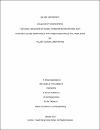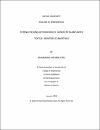Performance of corrosion-aged Reinforced Concrete (RC) beams rehabilitated with Fabric-Reinforced Cementitious Matrix (FRCM)
Abstract
This paper reports on the feasibility of using fabric-reinforced cementitious matrix (FRCM) systems to rehabilitate corrosion-damaged reinforced concrete (RC) beams. Seven large-scale RC beams were constructed and tested to failure under four-point load configuration. Six beams were subjected to an accelerated corrosion process for 70 days to obtain an estimated mass loss of 10% in the tensile steel reinforcing bars. One virgin beam and one corroded unrepaired beam were used as benchmarks for comparison purpose. The other five corroded beams were repaired before applying the FRCM system. The test parameters included the number of fabric plies (1, 2, and 4) and the strengthening schemes (end-anchored bottom flexural strips and fully U-wrapped flexural strips). Test results showed that corrosion insignificantly reduced the yield and the ultimate strength of the specimen. However, the corroded specimen failed to meet the provisions of the ACI 318 code for crack width criteria. The use of FRCM increased the ultimate capacity of corroded beams between 6% and 46% and their yield strength up to 20% in comparison with those of the control virgin beam. The specimens repaired with U-wrapped FRCM strips showed higher capacity and higher ductility than those repaired with the end-anchored bottom strips having similar number of layers. A higher gain in the flexural capacity and a lower ductility index were reported for specimens with higher amount of FRCM layers. 2016 International Committee of the SCMT conferences. All rights reserved.
DOI/handle
http://hdl.handle.net/10576/22758Collections
- Civil and Environmental Engineering [892 items ]
Related items
Showing items related by title, author, creator and subject.
-
Flexural Behavior Of Basalt Fiber Reinforced One-Way Concrete Slabs Reinforced With Fiber Reinforced Polymer Bars
Rihan, Yousrf Adnan Omer (2018 , Master Thesis)The State of Qatar suffers from a harsh environment in the form of high temperature that prevails almost all year round, in addition to severe humidity and coastal conditions. This exposure leads to the rapid deterioration ... -
Strengthening of Continuous Reinforced Concrete Beams Using Steel Reinforced Grout
Ibrahim, Mohamed Amin Babiker (2025 , Dissertation)This study investigated the effectiveness of steel-reinforced grout (SRG) in enhancing the flexural performance of continuous reinforced concrete (RC) beams. Twenty medium-scale, two-span RC beams were designed, fabricated, ... -
Strengthening of reinforced concrete beams With Textile- Reinforced mortars
Afzal, Muhammad Shekaib (2016 , Master Thesis)This study involves an experimental work for using textile reinforced mortar (TRM) to increase the flexural strength of reinforced concrete (RC) beams. Two different types of textiles namely carbon and Polyparaphenylene ...



